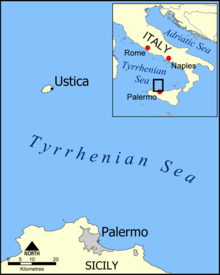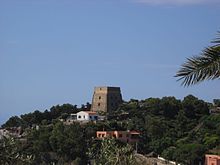Ustica
| Ustica | ||
|---|---|---|

|
|
|
| Country | Italy | |
| region | Sicily | |
| Metropolitan city | Palermo (PA) | |
| Local name | Ùstica | |
| Coordinates | 38 ° 43 ' N , 13 ° 11' E | |
| height | 49 m slm | |
| surface | 8 km² | |
| Residents | 1,302 (Dec. 31, 2019) | |
| Population density | 163 inhabitants / km² | |
| Post Code | 90010 | |
| prefix | 091 | |
| ISTAT number | 082075 | |
| Patron saint | San Bartolomeo | |
| Website | Ustica | |
 Ustica locality |
||
Ustica [ ˈustika ] is a small volcanic island in the Tyrrhenian Sea north of Sicily . Ustica is also the name of the only municipality on the island that belongs to the metropolitan city of Palermo and thus to the autonomous region of Sicily and has 1302 inhabitants (as of December 31, 2019).
Location and dates
The island of Ustica has an area of 800 ha, the highest point is the Monte Guardia dei Turchi with 240 m. The island is 66 km from the provincial capital, Palermo .
Economy and Transport
The inhabitants live mainly from agriculture. The fertile soils are suitable for growing citrus fruits, cereals, olives and wine. Other important sources of income are fishing and tourism. The unique underwater world makes the island a popular destination for divers . In front of Cala Santa Maria there are Roman ruins and shipwrecks to explore underwater . The most famous dive site is the Grotta dei Gamberi , a cave that is inhabited by unicorn shrimps , whose eyes reflect the light of the lamps on the walls and the cave ceiling. There are also areas of seagrass and rocks around the island, which are among the best dive sites in the Mediterranean . At the Secca della Colombara dive site there is a shipwreck where large swarms of barracudas reside.
Several ferries run between Palermo and Ustica every day. The ferries take two to three hours to cross.
history
Finds show that the island dates back to the 15th century BC. Was inhabited. Was discovered u. a. a Bronze Age village protected by a defensive wall , I Faraglioni, which existed from this time. The finds show close parallels to the Middle Bronze Age Milazzese culture of the Aeolian Islands (approx. 1450–1270 BC), so that research assumes that this culture extended to Ustica. The Greeks called the island Osteodes ("ossuary") because thousands of mutineers from Carthage starved there. Since the Roman rule , the island has been called Ustica (from ustum "burned") because of the black lava rock . In the course of further history it was under the rule of the Arabs and the Normans . The island was subject to frequent pirate raids until the 18th century.
In 1763 Ustica came into the possession of the French-born House of Bourbon-Sicily . At that time a fortress with two defense towers was built and the island capital was founded. Immigrants from the Aeolian Islands populated the area. Archduke Ludwig Salvator wrote a detailed description of the island .
As the population grew rapidly in the second half of the 19th century and at the beginning of the 20th century, many families emigrated to America and settled mainly in the New Orleans area .
During the time of Italian fascism , the island served as a place of exile (confino) for unpopular political opponents such as Antonio Gramsci and Amadeo Bordiga , the founder of the Italian Communist Party .
After Italy entered the war in June 1940, the existing infrastructure was expanded and the functional designation was adapted in order to admit “ Communist ex- Yugoslavs ” as internees in a new parallel internment camp (campo di concentramento) to be created . In fact, internees and confinati lived with and next to each other, whereby the enforced closeness contained a lot of potential for conflict. The confinati also included non-political criminals who stole from the other deportees and made life difficult for them.
On June 27, 1980, an airplane of the type Douglas DC-9-15 of the Italian airline Itavia crashed near Ustica . All 81 inmates were killed.
legend
Ustica plays a role in localizing individual episodes of Homer's Odyssey . The floating island of the wind god Aiolos was equated with Ustica, among others. Armin Wolf, on the other hand, concludes from the geographical descriptions and wind direction information in the Odyssey that Ustica corresponds to Aiaia , the island of Kirke .
Attractions
- Archaeological sites from the Bronze Age
- Excavations of late Roman ceramic vessels
- Museum with underwater finds
- Riserva naturale marina Isola di Ustica , Italy's first underwater nature reserve
Events
- Every year in June and July there is an international exhibition for water sports.
- The colorful house fronts typical of the island are the result of an annual wall painting competition.
- Festa di San Bartolomeo: In honor of St. Bartholomew , patron saint of the island since 1763, a festival is celebrated annually on August 24th, Bartholomew's Day. It includes u. a. Boat races, pot hitting , various artistic performances and fireworks .
Web links
- More information on the Sicily Region website
Individual evidence
- ↑ Statistiche demografiche ISTAT. Monthly population statistics of the Istituto Nazionale di Statistica , as of December 31 of 2019.
- ↑ tauchen-ustica.de
- ^ Anna Maria Bietti Sestieri : The Bronze Age in Sicily. In: Harry Fokkens, Anthony Harding (eds.): The Oxford Handbook often the European Bronze Age. Oxford University Press 2013, pp. 658 f.
- ↑ Carlo Spartaco Capogreco: I Campi del duce. L'internamento civile nell'Italia fascista (1940-1943). Einaudi, Torino 2004, pp. 246-247.
- ↑ z. B. Ernle Bradford : Traveling with Homer. Deutscher Taschenbuch-Verlag, Munich 1992, ISBN 3-423-30310-7 .
- ↑ Armin Wolf : Homer's Travels. In the footsteps of Odysseus. revised new edition. Böhlau-Verlag, 2009, ISBN 978-3-412-20407-5 , p. 52ff. (First edition 1968)
- ↑ Information at fest-sagre.it (Italian)





